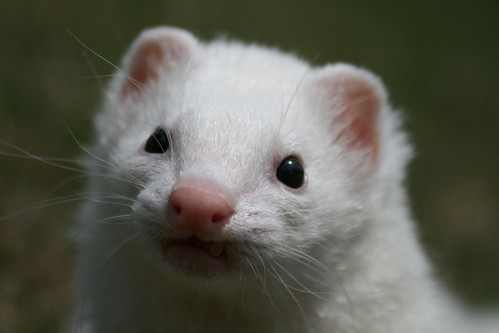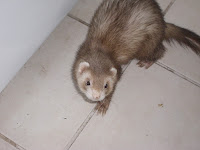Albino: Albino ferrets have a white or off-white undercoat with matching white or off-white guard hairs and pinkish or red eyes. For showing purposes (yes, there are ferret shows), a pure white ferret with ruby red eyes is preferred.
 Dark Eyed White (DEW): DEW ferrets are similar in colour to albinos, but while Albinos have red eyes, DEW ferrets have dark burgundy eyes. Also unlike Albinos, DEW ferrets do not have to be entirely white. DEW undercoats must be white, but a few coloured guard hairs are acceptable so long as the coloured guard hairs are less than 10% of the coat. Neither Albinos nor DEW can have smudges or masks.
Dark Eyed White (DEW): DEW ferrets are similar in colour to albinos, but while Albinos have red eyes, DEW ferrets have dark burgundy eyes. Also unlike Albinos, DEW ferrets do not have to be entirely white. DEW undercoats must be white, but a few coloured guard hairs are acceptable so long as the coloured guard hairs are less than 10% of the coat. Neither Albinos nor DEW can have smudges or masks. Roan: Formerly known as silver, these ferrets have a mixture of white and black guard hairs making them appear silver in colour. The ideally, the mixture should be between 50 and 60% black and 40-50% white, with the amount of black guard hairs determining how dark the nose and mask should be. Like DEW ferrets, Roan ferrets hard dark burgundy eyes.
Roan: Formerly known as silver, these ferrets have a mixture of white and black guard hairs making them appear silver in colour. The ideally, the mixture should be between 50 and 60% black and 40-50% white, with the amount of black guard hairs determining how dark the nose and mask should be. Like DEW ferrets, Roan ferrets hard dark burgundy eyes.
Champagne: Champagne ferrets have light tan coloured guard hairs white or cream coloured undercoats, a pink nose with a beige T outline and burgundy eyes.
Cinnamon: Cinnamon ferrets have light, cinnamon coloured guard hairs with a light gold or off-white undercoat, burgundy eyes and a brick coloured or brick outlined nose.

Chocolate: Chocolate ferrets have light brown or chocolate coloured guard hairs, and a gold or white undercoat. Their noses are pink or brick coloured and may have a brown T outline. (Chocolate on right)

Sable: Probably the most common colour of ferret, these fuzzies have dark brown guard hairs, a white or cream coloured undercoat, a dark brown or brown spotted nose and dark brown eyes.

Black Sable: The eyes and undercoat of the black sable ferret is the same colour as a sable, but black sables have guard hairs that are so thick and dark that the undercoat barely shows through. Their noses are black or specked with black.

Black: Black ferrets are not very common. Their guard hairs are black (not simply dark brown) and their undercoat is white or light gold. The eyes are black or near black and the nose is black or black speckled.


Hi great entry, although other than black coated ferrets, they tend to change colors and coat style over the period of 2-8 years. Its only during their older years they stay as a one set color.
ReplyDeleteThank you for reminding me about that! I totally forgot to mention if! That's true that their coat colour will vary a bit, but it won't change all together. For example, a true sable won't suddenly become a DEW, but a baby black sable may lighten as it gets older and become a light sable. I had a ferret that was a dark silver with a mask. He lightened so much over the years that his mask disappeared and, when he was about 8, he was closer to a DEW! (Though his black content was closer to 20%, disqualifying him from DEW classification)
ReplyDeleteThe pic you have placed with the black ferret description actually is not a ferret at all. It's a khonorik - russian hybrid of european mink and polecat. A totally different animal, with tough temperament, not suitable as a pet in most cases.
ReplyDeleteHere will be the original picture and also a short description: http://www.ferret.ru/eng/khonorik.html
Yes, I am aware that it is a hybrid, but it is still a black - the guardhairs are so dark that the undercoat cannot be seen through them. Unfortunately, true black ferrets are not very common at all (especially mature black ferrets), so finding a picture of one was not possible. I thought about mentioning the fact that the pictured animal was a hybrid, but then didn't really think that most people would notice... sharp eye!
ReplyDelete